
by Julienne Givot | Mar 4, 2013 | Major Arcana Heros Journey, Podcasts |

The Rider-Waite Tower card
Is it the Tower of Destruction or the House of God? In card number sixteen of the Major Arcana, we are met with yet another image that often inspires fear and superstition.
This is the first podcast in which Julienne Givot and Cyndera Quackenbush are divorced from their own tower (the recording studio) and explore this card’s symbolism from the telephone. With the sudden shock experienced in this stage of the fool’s journey, will those tethered to their addictions be struck from their habits? Does hitting rock bottom ultimately free us?
Cyndera explores how a client once completely dissembled her own psychic castle and Julienne reveals the qualities of the Liberator archetype. A closer look at current events and films such as the Hunger Games, Castaway and Groundhog Day also helps us all to “think outside the tower.” Also, don’t miss this podcast’s first homework assignment to watch Beasts of the Southern Wild through the lens of the Archetypal Tarot Journey. We’ll be discussing it in the next edition along with the 17th card of the major arcana: The Star.
Details and references below.
Questions or suggestions? Email us ATPodcast@archetypist.com
Archetypes related to the Tower card: The Liberator

The Tower from the Marseilles deck
Popular Associations with the Tower Card:
- Chaos —– Sudden change —– Impact —– Hard times
- Crisis —– Revelation —– Disruption —– Realizing the truth
- Disillusion —– Crash —– Burst —– Uncomfortable experience
- Downfall —– Ruin —– Ego blow —– Explosive transformation
Film references for The Tower Card:
Cast Away (2000) Tom Hanks – A FedEx executive is transformed physically and emotionally after a crash landing on a deserted island.
The Hunger Games (2012) – Jennifer Lawrence
The Beasts of The Southern Wild (2012)
Film references for the Liberator archetype:
Lincoln (2012)
Norma Rae (1979)
Religion/Myth: Milarepa – Buddhist Saint who had to rebuild a tower again and again as a part of his karma.
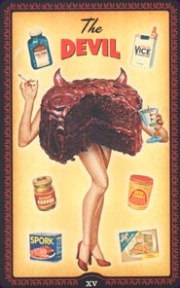
by Julienne Givot | Jan 25, 2013 | Major Arcana Heros Journey, Podcasts |

The Devil card of the Marseilles
As we enter the last row of our Tarot Journey (and a new year for the Archetypal Tarot Podcast), we are met with the formidable character of The Devil, the fifteenth card of the Major Arcana. Our hero, well on the path to rebirth, must first meet his own shadow and face addictions and attachments.
Julienne Givot and Cyndera Quackenbush also discuss the Pan-like characteristics of the Devil, who invites human beings to recognize their animal natures that rebel when they are suppressed. As always, this podcast adds to your growing movie list with some subtle and interesting studies of the Devil archetype in film.
Archetypes related to the Devil card: Provocateur, Addict, Scapegoat, Addict/Mystic, Perfectionist
Key Words:
- Materialism —– Ignorance —– Stagnation —– Self-bondage
- Lust —– Egoism —– Obsession —– Anxiety —– Anger
- Hedonism —– Passion —– Instincts
- Sexuality —— Temptation —– Doubt —– Vice
- Futility —– Physical attraction —– Pessimism —– Insight
Film References for The Devil Card:
Charlie And The Chocolate Factory (2005) and Willy Wonka and The Chocolate Factory (1971) There are many references to the archetype of the Devil, Provocateur and Addict in these films. Each member of the group (both children and adults) is obsessed with getting something, food (Augustus Gloop), attention (Veruca Salt), being right (Mike Teevee) or even something as innocent as wanting a better life for their family (Charlie). Everyone is tempted and everyone gives in to the temptation, Charlie though is true to the angel of his better nature at the end of the film.
Election (1999) Reeese Whitherspoon & Matthew Broderick.

The Housewives tarot Devil card
The Addict archetype:
Every one of us is touched by the Addict archetype. Besides the usual suspects–drugs, alcohol, food, and sex–one can be addicted to work, sports, television, exercise, computer games, spiritual practice, negative attitudes, and the kinds of thrills that bring on adrenaline rushes.
In its positive aspect, this archetype helps you recognize when an outside substance or influence has more authority over your will power than does your inner spirit.
Confronting addiction and breaking the hold that a pattern or substance has on you can impart great strength to your psyche. Discovering the empowerment that comes with perseverance has a life-long impact, “I know now that if I can quit _______, I can do anything.”
From a symbolic perspective, the shadow aspect of the Addict represents a struggle with will power and the absence of self-control. The shadow Addict compromises your integrity and honesty. The shame associated with addiction.
Film References for the Addict archetype:
Natalie Portman – Black Swan (2010)
Ben Stiller – Permanent Midnight (1998)
Ed Harris in Pollock (2000)
Anne Hathaway in Rachel Getting Married (2008)
Robert Downey Jr. in Less Than Zero (1987)
Nicholas Cage and Elizabeth Shue in Leaving Las Vegas (1995)
Leo DiCaprio – The Basketball Diaries (1995)
Religion/Myth: Tantalus he was invited to share the food of the gods but abused the honor and was punished by being “tantalized” for all eternity by food and drink he could not reach).
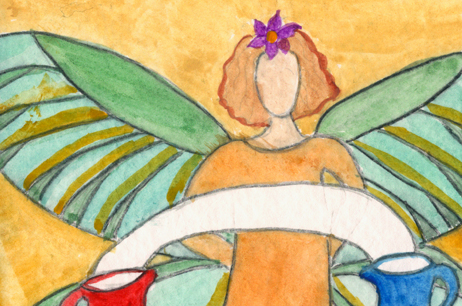
by Julienne Givot | Dec 17, 2012 | Major Arcana Heros Journey, Podcasts |
“What we strive for in perfection is not what turns us into the lit angel we desire.” ~David Whyte

Julienne’s rendition of the Temperance card
With a little rest after the Death card the Archetypal Tarot Podcast explores the beginning of the rebirth cycle with Temperance – the fourteenth card of the Major Arcana. Julienne Givot and Cyndera Quackenbush discuss the Angel archetype and the healing and recovery that can take place internally and even below conscious awareness. At the end of our second row, the Realm of Equilibrium, we have a resolution to the ongoing theme of opposites. Here, two elements are alchemized to create “the third thing” that mediates and transforms opposing realities. Listen to the podcast for more on this next step of the journey.
References
Cyndera mentions A Blue Fire by James Hillman specifically chapter 3.
Julienne mentions this related article: Original Fairy Godmother
“I am loath to close. We are not enemies, but friends. We must not be enemies. Though passion may have strained it must not break our bonds of affection. The mystic chords of memory, stretching from every battlefield and patriot grave to every living heart and hearthstone all over this broad land, will yet swell the chorus of the Union, when again touched, as surely they will be, by the better angels of our nature.”
~Abraham Lincoln’s first inaugural address
 Angel & Fairy Godmother/Godfather Archetypes in Films & Television:
Angel & Fairy Godmother/Godfather Archetypes in Films & Television:
-Angels In America – The Play / TV Mini Series (2003)
-Aunt March played by (Mary Wickes) in Little Women (1994)
-It’s A Wonderful Life – Film (1946)
-Danny Glover, Kevin Kline in Grand Canyon (1991)
-Rosalind Russell as Mame Dennis in Auntie Mame (1958)
-Audrey Tatou in Amelie (2001)
-Dustin Hoffmann in Mr. Magorium’s Wonder Emporium (2007)
-Robert DeNiro as Captain Shakespeare in Stardust (2007)
Shadow:
-Marlon Brando in The Godfather trilogy
-Glenn Close in Dangerous Liaisons (1988)
Television:
-Touched by an Angel
-What Not To Wear
Fairy Tales:
-Glinda in The Wonderful Wizard of Oz by L. Frank Baum
The Winter of Listening
By David Whyte
No one but me by the fire,
my hands burning
red in the palms while

Rider-Waite Temperance Card
the night wind carries
everything away outside.
All this petty worry
while the great cloak
of the sky grows dark
and intense
round every living thing.
What is precious
inside us does not
care to be known
by the mind
in ways that diminish
its presence.
What we strive for
in perfection
is not what turns us
into the lit angel
we desire,
what disturbs
and then nourishes
has everything
we need.
What we hate
in ourselves
is what we cannot know
in ourselves but
what is true to the pattern
does not need
to be explained.
Inside everyone
is a great shout of joy
waiting to be born.
Even with the summer
so far off
I feel it grown in me
now and ready
to arrive in the world.
All those years
listening to those
who had
nothing to say.
All those years
forgetting
how everything
has its own voice
to make
itself heard.
All those years
forgetting
how easily
you can belong
to everything
simply by listening.
And the slow
difficulty
of remembering
how everything
is born from
an opposite
and miraculous
otherness.
Silence and winter
has led me to that
otherness.
So let this winter
of listening
be enough
for the new life
I must call my own.
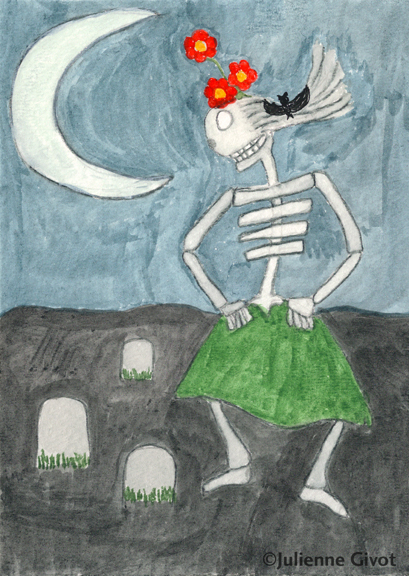
by Julienne Givot | Nov 18, 2012 | Major Arcana Heros Journey, Podcasts |
“We must let go of the life we have planned, so as to accept the one that is waiting for us.” ~Joseph Campbell
 Who knew that Death could be so funny? But here it is, card number 13 in the Major Arcana. Join Julienne and Cyndera as they look at the archetype of Death from a symbolic and psychological point of view with a dash of added humor. Learn why this inevitable stage for the Hero isn’t the end but an important element to the rest of the journey.
Who knew that Death could be so funny? But here it is, card number 13 in the Major Arcana. Join Julienne and Cyndera as they look at the archetype of Death from a symbolic and psychological point of view with a dash of added humor. Learn why this inevitable stage for the Hero isn’t the end but an important element to the rest of the journey.
The Death card liberates all that has reached its end, and cuts away stagnation so that life can continue. Beyond the literal interpretation of this card, there is a rich array of deaths that visit in our daily lives: the end of jobs, relationships and also the visitations of depressions and other forms of “falling apart.” What advantages are there to dismemberment and disintegration? How do Zombies and Batman play a role at exploring this the ultimate mystery of life – it’s end. Or is it the end? You’ll just have to get the podcast and find out.
PS: Listen to all the way to the end for a surprise (and possibly a laugh or two).
Resources Mentioned in the Podcast:
Key Words:
- Ending of a cycle – Loss – Conclusion – Sadness
- Transition into a new state – Psychological transformation
- Finishing up – Regeneration – Elimination of old patterns
- Being caught in the inescapable – Good-byes – Deep change
Film / TV References:
The Dark Knight Rises (2012
Sean of the Dead (2004)
Star Trek II: The Wrath of Khan (1982)
Bones (2005-present)
Dead Like Me (2003-2004)

Julienne’s rendition of Card 13: Death
“Yet through depression we enter depths and in depths find soul. Depression is essential to the tragic sense of life. It moistens the dry soul, and dries the wet. It brings refuge, limitation, focus, gravity, weight, and humble powerlessness. It reminds of death. The true revolution begins in the individual who can be true to his or her depression. Neither jerking oneself out of it, caught in cycles of hope and despair, nor suffering it through till it turns, not theologizing it – but discovering the consciousness and depths it wants. So begins the revolution in behalf of soul.”
~ from Re-Visioning Psychology by James Hillman
The Holy Longing
Tell a wise person, or else keep silent,
because the mass man will mock it right away.
I praise what is truly alive,
what longs to be burned to death.
In the calm water of the love-nights,
where you were begotten, where you have begotten,
a strange feeling comes over you,
when you see the silent candle burning.
Now you are no longer caught in the obsession with darkness,
and a desire for higher love-making sweeps you upward.
Distance does not make you falter.
Now, arriving in magic, flying,
and finally, insane for the light,
you are the butterfly and you are gone.
And so long as you haven’t experienced this: to die and so to grow,
you are only a troubled guest on the dark earth.
Goethe
(translated by Robert Bly)
Like what you heard on the podcast? Share us on Facebook (handy button below) or give us a review on iTunes.
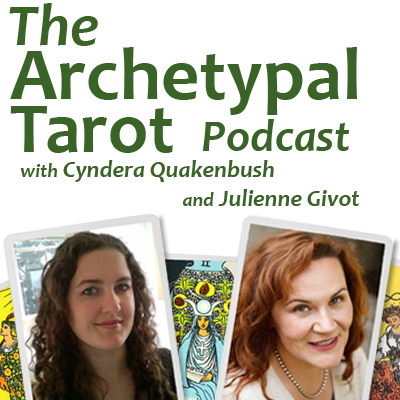
by Julienne Givot | Oct 25, 2012 | Podcasts |
We’re pretty pleased to announce that The Archetypal Tarot Podcast is not available on Stitcher Radio. If you haven’t heard of Stitcher from their sponsorship of many great radio shows like “This American Life” or “RadioLab” let me tell you that it is pretty darn cool and a must for those of us who love talk radio and podcasts. Oh and it’s a free app which you can download from your iPhone/iPad or Android app store.
You can even scroll all the way down to the footer of this page to listen to the most recent episode.

Click this image to hear the latest episode.
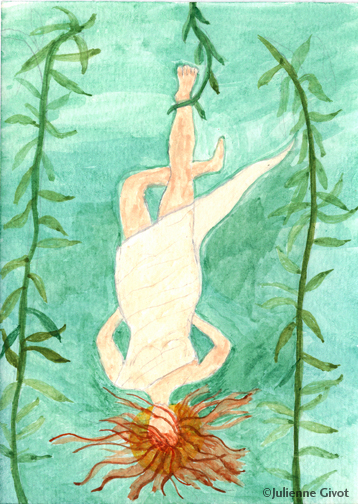
by Julienne Givot | Oct 21, 2012 | Major Arcana Heros Journey, Podcasts |
Listen Now! or Subscribe in iTunes
What happened!?! Our hero is hanging upside down! In the thirteenth edition of the Archetypal Tarot Podcast Julienne Givot and Cyndera Quackenbush help to dispel the superstition that often surrounds cards such as The Hanged Man, card number twelve in the Major Arcana. After an exploration of the Hanged Man’s symbolic imagery and the martyr archetype, this podcast illuminates an invitation to test the inner strength gained in the previous card and make valuable sacrifices during this period of “hang time” (yes, a sports reference made its way into the podcast). Also join the discussion of movies featuring the martyr archetype – you may just find a new perspective, or your world turned upside down!
Cyndera also references this animation of a talk by Alan Watts done by the creators of South Park.

Julienne’s rendition of The Hanged Man
(watercolor on paper)
Julienne’s article goes deeper into the myth and motivation of the Martyr Archetype.
Key Words:
- Sacrifice – Letting go – Surrendering – Passivity
- Suspension – Acceptance – Renunciation – Patience
- New point of view – Contemplation – Inner harmony
- Conformism – Non-action – Waiting – Giving up
Film References:
For the Hanged Man – pay attention to the course that Paul Giamatti’s character takes in The Lady In The Water (2006) as he is pulled out of his self-induced isolation to become a Hero and what he needs to sacrifice to do so.
The Martyr in Film:
Meryl Streep in Silkwood
Ben Kingsley in Gandhi
Sean Penn in Milk
The Martyr in Books:
Little Bee by Chris Cleave
The Happy Prince by Oscar Wilde
Like what you heard on the podcast? Share us on Facebook (handy button below) or give us a review on iTunes.

Rider Waite Hanged Man card
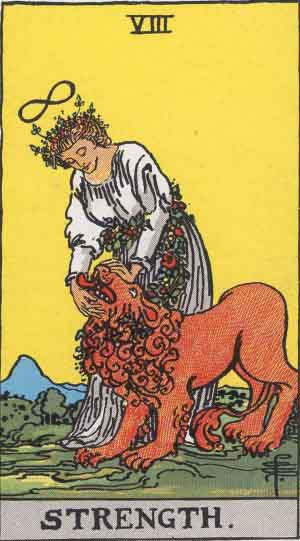
by Julienne Givot | Sep 18, 2012 | Major Arcana Heros Journey, Podcasts |
Listen Now! or Subscribe in iTunes

The Strength card as depicted in the Rider Waite deck
The Archetypal Podcast returns from its Summer Sabbatical with its Twelfth Edition starring the eleventh Tarot card, Strength. After a turn on the Wheel of Fortune our Hero/Fool is taken in a new direction and learns from the Lion and Maiden depicted in this card. Inner strength is called for with the knowledge that it’s made up of patience, self-control, and the awareness of one’s instincts and drives. Archetypal Consultant Julienne Givot gives us the breakdown of the empowered and disempowered archetype of the Damsel and reflections on Beauty and the Beast. Tarot Consultant Cyndera Quackenbush regales us with a retelling of an ancient Korean myth about a woman’s lesson in true courage. See below for a written version of the story.
Key Words:
- Fortitude – Lust – Courage – Patience
- Self-control – Being solid – Patience – Compassion
- Composure – Stability – Perseverance – Moderation
- Kindness – Gentleness – Slowness – Softness
- Serenity – Comprehension – Discipline – Inner strength
Film References:
La belle et la bête (Beauty and the Beast) by Jean Cocteau (1946)
Wizard of Oz (The Cowardly Lion and Dorothy) (1939)
Like what you heard on the podcast? Share us on Facebook (handy button below) or give us a review on iTunes.
The Tiger’s Whisker – A Korean Folktale
A young woman came one day to the house of a mountain hermit to seek his help. The hermit was a sage of great renown and a maker of charms and magic potions. When the young woman entered his house, the hermit said, without raising his eyes from the fireplace: “Why are you here?”
She said: “Oh, Famous Sage, I am in distress! My husband, who has just returned from fighting in the wars, hardly speaks to me and is as cold as ice. If he does speak it is with the most explosive fire in his voice! And he no longer enjoys the delicious food that he used savor at our supper table. I want a potion to give my husband so that he will be loving and gentle, as he used to be.””Ha, so simple is it? Can we cure a sick world with a potion?” the hermit said.”Master,” said the woman, if you do not help me, I am truly lost!”
Resigned at last, the hermit said, “Very well; I will help you to make a potion. But it requires an ingredient which I do not possess. The most essential ingredient is a the whisker of a living tiger.”
“The whisker of a living tiger!” She exclaimed. “How will I possibly get that?”
“If the potion is important enough, you will succeed,” the hermit said. He turned his head away, not wishing to talk anymore.
The young woman went home. She thought a great deal about how she would get the tiger’s whisker. Then one night she crept from her house with the most delicious morsels she had cooked especially for her task. She went to the place on the mountainside where the tiger was known to live. Standing far off from the tiger’s cave, she held out the food, calling the tiger to come and eat. The tiger did not come.
The next night She went again with some well-prepared food, this time a bit closer. Again she offered the food to the tiger. Every night she went to the mountain, each time a few steps nearer to the tiger’s cave and even though fear caused her knees to shake she took these footsteps forward.
Little did the young woman know, but the tiger was becoming accustomed to her presence and every night was also creeping closer in her direction. Eventually, one night, the two could see eachother in the moonlight just a stone’s throw apart. It happened again the next night and they were so close she could feel the warmth of the great feline’s breath. As the tiger knelt to eat the food she had given him, She reached out a hand very quickly and plucked a whisker from the Tiger’s face-
And the tiger
pretended
not to notice…
Clutching the whisker tightly in her hand, she backed away slowly, thanking the tiger softly and then went down the path, walking not running, towards the mountain hermit’s house.
“Oh, Famous One!” She cried, ” I have it! I have the tiger’s whisker! Now you can make me the potion you promised so that my husband will be loving and gentle again!”
The hermit took the whisker and examined it, his face alit by the flames of his firepit. Satisfied that it had really come from a tiger, he leaned forward and dropped it into the fire. It vanished immediately in the smoke.
“Oh sir!” the young woman called in anguish. “What have you done!” She proceeded to tell him the story of how patiently, over many weeks she had approached the tiger. “But you have thrown the whisker in the fire! It is all for nothing.”
“No, I do not think it is all for nothing,” explained the hermit. “Is any person more vicious than a tiger? The potion in which you sought was your own courage. You thought you did not have courage because you were afraid of a man. But true courage is being able to feel the fear and still take those steps forward. If you can win the confidence of such a wild creature, surely you can do the same with your husband?”
Hearing this, the young woman stood speechless for a moment. Then she went down the trail, walking but not running, towards home.
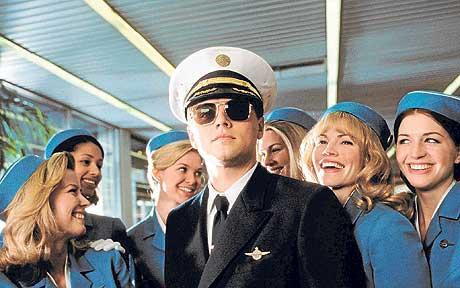
by Julienne Givot | Jun 17, 2012 | Major Arcana Heros Journey, Podcasts |
Listen Now! or Subscribe in iTunes
You can’t plan this stuff! In card number 10, the Archetypal Podcast is met with the Wheel of Fortune – a fortuitous card that marks a new stage of awareness in the Fool’s journey. After evaluating new moral issues presented by Justice, and time to reflect with the Hermit, the Fool/Hero is ready to chance life more consciously with The Wheel of Fortune. Though she thinks she may have control, the Wheel (often a favorable card when appearing in Tarot readings) quickly shows her that much of life is an inexorable force operating out of our control. Taking their own risks with this card, Julienne and Cyndera discuss an archetype addressing the fortune seekers of the world – The Gambler. Also the voice of the Victim emerged in the podcast, whispering woes from the bottom of the Wheel and warning against buying furniture in “Suckland”. From lessons learned in both life’s wins as well as losses, the message of this card is to let go and spin where the wheel takes you. As always, there is a lively discussion of film, psychological inquiry and insight.
 Examples of the Gambler/Wheel of Fortune Archetype in film:
Examples of the Gambler/Wheel of Fortune Archetype in film:
Catch Me If You Can (2002) Leonardo DiCaprio and Tom Hanks
Ocean’s Eleven (2001), Twelve (2004) and Thirteen (2007)
Key Words:
• Turning point —– Opportunities —– Possibilities
• Destiny —– Fate —– Superior Forces —– Movement
• Development —– Activity —– Surprises —– Expansion
• Sudden Events —– Speed —– New Developments —– Life Cycles
• Interpretation —– Sudden Change —– Dissension —– Approachability
Like what you heard on the podcast? Share us on Facebook (handy button below) or give us a review on iTunes.
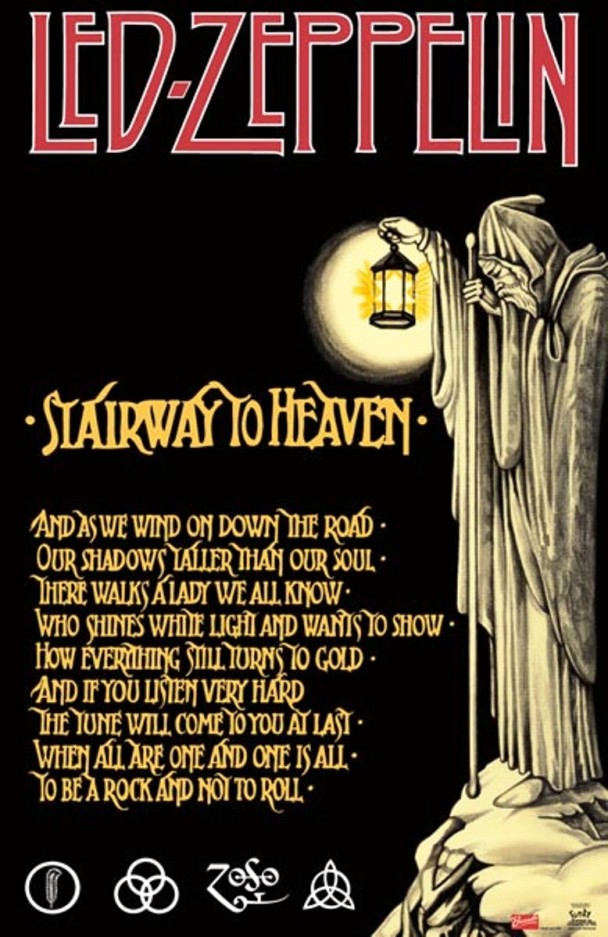
by Julienne Givot | May 21, 2012 | Major Arcana Heros Journey, Podcasts, Pop Culture Archetypes |
The Tenth edition of the Archetypal Podcast takes us to meet The Hermit, a figure waiting off the beaten track with the wisdom

that only remote regions can give. Card number 9 allows our hero traveling through the Major Arcana to either meet or become this humbled figure full of in-sight, as represented by his seeking lantern. A re-evaluation of his journey is required after a run-in with the objectivity of Justice, before he can once again chance the Wheel of Fortune (Card number 10). Consideration of this card allows us all a moment to reflect without being sucked into eternal isolation – the shadow side of the Hermit. Fresh from a (hot) visit from her hometown of Joshua Tree, California, Cyndera shares fresh inspiration after encountering an old friend who embodies the Hermit archetype. Julienne takes us on a tour of the hermitic nature of the American literary Renaissance along with some insights on the Hermit from film and popular culture.
Light Aspect: Integration, Introspection
Shadow Aspect: Isolation
Examples of the Hermit:
Henry David Thoreau (esp his book Walden) there is a great podcast about Thoreau from the public radio program ‘To The Best of Our Knowledge’.
Buddhist teacher, Pema Chodron, author and Catholic mystic Thomas Merton, poet Emily Dickinson, naturalist John Muir Also of interest is the Hermitary website filled with even more insight on the Hermit archetype.
 I also found it amusingly appropriate that Led Zeppelin used the image of the Hermit for their single ‘Stairway To Heaven’ which carries lyrics capturing the ideas of the Hermit’s quest.
I also found it amusingly appropriate that Led Zeppelin used the image of the Hermit for their single ‘Stairway To Heaven’ which carries lyrics capturing the ideas of the Hermit’s quest.
In film:
Robert Duvall in Get Low (2009)
Emile Hirsh in Into the Wild (2007)
Bill Murray in Lost in Translation (2003)
Forest Whittaker in Ghost Dog (1999) (Combination of Hermit and Warrior)
Key Words:
• Introspection —– Silence —– Guidance —– Reflection
• Solitude —– Looking inward —– Reclusion —– Being quiet
• Inner search —– Deep understanding —– Isolation
• Distance —– Retreat —– Philosophical attitude
Like what you heard on the podcast? Share us on Facebook (handy button below) or give us a review on iTunes.

by Julienne Givot | Apr 29, 2012 | Major Arcana Heros Journey, Podcasts, Pop Culture Archetypes |
Listen Now! or Subscribe in iTunes
The Ninth edition of the Archetypal Tarot Podcast attempts to do justice to the Justice card, which

is number 8 of the Major Arcana.
After setting out on a newly realized journey on the Chariot, our hero quickly faces some form of judgement. Justice, pictured as a stern-looking woman is reminiscent of the Goddess of Wisdom, Athena, who assists our hero to view his challenges with a rational, dispassionate perspective. Holding both sword and scales, Justice cuts through to truth and weighs the balance of our ways. Listen in as Julienne recounts the myth of Solomon and also explores the shadow side of Justice. The archetype of the Avenger is briefly explored as Cyndera poses a question to our podcast audience: Do the ends justify the means if the oppressed triumph over their oppressors by using methods that mirror their oppressors’ ways?
We are asked to leave the subjectivity of the Hero for the wisdom and objectivity of the Judge and Mediator archetypes.
Listen in on a conversation with Tarot consultant Cyndera Quakenbush and
Archetypal Consultant, Julienne Givot, as they discuss the symbolic and real world qualities of these archetypal characters.
Recommended reading:
Jung and Tarot: And Archetypal Journey by Sallie Nichols
Examples of the Judge in Film/TV/Drama:
Empowered/Light Aspect
- Gene Hackman in Mississippi Burning ( 1988)
- Gregory Peck in To Kill A Mockingbird (1962)
- Anthony Hopkins in Amistad (1997)
- Meryl Streep in Iron Lady (2011)
- Hugo Weaving in The Lord of the Rings (2001)
- The character of Oberon in Midsummer Nights Dream
Un-empowered/Shadow aspect:
- Raymond Massey in East of Eden (1955)
- Lena Headey as Cersiei in Game of Thrones (HBO 2011/12)
- Tsai Chin in Joy Luck Club – both shadow and light (1993)
Like what you heard on the podcast? Share us on Facebook (handy button below) or give us a review on iTunes.

by Julienne Givot | Mar 23, 2012 | Major Arcana Heros Journey, Podcasts, Pop Culture Archetypes |
Listen Now! or Subscribe in iTunes
The Chariot: Hero, Warrior, and the Crossing of the First Threshold

The Eighth edition of the Archetypal Tarot Podcast explores the movement and meaning encompassed by the Chariot, card number 7 of the
Major Arcana. For the first time, we see our hero of the deck breaking beyond the boundary of the Emperor’s domain. In the last stage, the Lovers, he was faced with a choice and is now thrust down a particular path, reminiscent of the “crossing of the first threshold” of
Joseph Campbell‘s stages of the
hero’s journey. Will all the wisdom of the figureheads from the previous stages help our hero in the real world? Julienne Givot connects in the ancient story of Arjuna as he faces the fears of battle under the guidance of Krishna. Cyndera Quackenbush illustrates the shadowy consequences of the heroic impulse by recounting the myth of Phaeton. The Chariot card allows us to find our own courage in the face of bold undertakings while keeping an eye on the dangers of hubris.
Listen in on a conversation with Cyndera Quakenbush and Julienne Givot, as they discuss the symbolic and real world qualities of these archetypal characters.
Recommended reading:
Way of the Peaceful Warrior by Dan Millman
The Seven Spiritual Laws of Superheroes: Harnessing Our Power to Change the World by Deepak and Gotham Chopra
King, Warrior, Magician, Lover: Rediscovering the Archetypes of the Mature Masculine by Robert Moore and Douglas Gillette
Examples of the Hero in Film/TV:
Empowered/Light Aspect
- Keanu Reeves as Neo in The Matrix (1999)
- Mark Hamill as Luke Skywalker in Star Wars (1977)
- Emma Thompson as Vivian Bearing in Wit (2001, TV)
- Judy Garland as Dorothy in The Wizard of Oz (1939)
- Ed Asner as Carl Fredrickson in UP (2009)
Shadow aspect:
- Jeremy Renner in The Hurt Locker (Hero/Warrior both shadow and light) (2010)
- James Franco as The 2nd Green Goblin in Spiderman 3 (2007)
Examples of the Warrior in Film/TV:
Empowered/Light Aspect
- Harrison Ford in Star Wars (1977)
- Jake Gylenhall as Anthony Swofford in Jarhead (2005)
- Sarah Michelle Geller in Buffy the Vampire Slayer (1997, TV)
- Shirley MacLaine in Terms of Endearment (battling cancer) (1983)
- Zoe Saldana as Nyteri in Avatar (2009)
- Katee Sackoff as Starbuck in Battlestar Gallactica (both shadow and light aspects, 2004, TV)
Shadow Aspect:
- Vin Diesel in the The Chronicles of Riddick (2004)
- Stephan Lang as Colonel Quaritch in Avatar (2009)
Like what you heard on the podcast? Share us on Facebook (handy button below) or give us a review on iTunes.
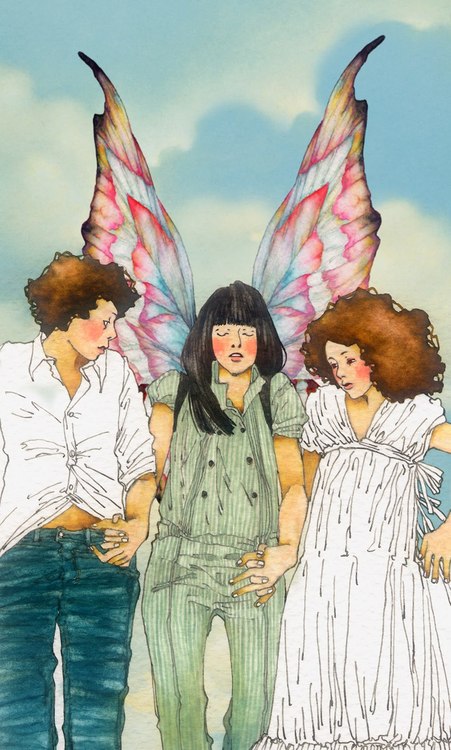
by Julienne Givot | Feb 15, 2012 | Major Arcana Heros Journey, Podcasts, Pop Culture Archetypes |
Listen Now! or Subscribe in iTunes
 The Seventh edition of the Archetypal Tarot podcast reveals our heroic Fool at his/her first genuine choice point represented by card number six, The Lovers. The Lovers brings into focus this important first choice and reminds us that love, balance and companionship are called for. This stage has us examine the archetypes of the Lover as well as the Companion. A reminder to access both our masculine ‘doing-ness’ and feminine receptivity.
The Seventh edition of the Archetypal Tarot podcast reveals our heroic Fool at his/her first genuine choice point represented by card number six, The Lovers. The Lovers brings into focus this important first choice and reminds us that love, balance and companionship are called for. This stage has us examine the archetypes of the Lover as well as the Companion. A reminder to access both our masculine ‘doing-ness’ and feminine receptivity.
Listen in on a conversation with
Tarot Dream Stone consultant Cyndera Quakenbush and
Archetypal Consultant, Julienne Givot, as they discuss the symbolic and real world qualities of these archetypal characters.
Further exploration of the archetype of the Lover: Seizing The Power of The Lover Archetype
Recommended reading:
We: Understanding the Psychology of Romantic Love by Robert A. Johnson
The Eden Project: In Search of he Magical Other by James Hollis
Cyndera recommends: The Lovers Path Tarot set by Kris Waldherr
Archetypes of The Lovers card:
Companion
Lover

The Lovers from the Dreaming Way Tarot
Examples of the Companion in Film/TV:
- Susan Sarandon and Geena Davis in Thelma and Louise (1991)
- Ben Affleck in Good Will Hunting (1997)
- Russell and Dug in the Pixar film UP ( 2009)
Examples of Both Light and Shadow:
- TV Show “Entourage”
- The Hangover
- Bridesmaids (2011)
Shadow or disempowered aspect:
- Eve Arden & Mare Winningham Mildred Pierce (1945 and 2011)
- Winona Ryder in Heathers (1988)
- The Social Network (2011)
Examples of the Lover in Film/TV:
- Dead Poet’s Society especially Neil Patrick Harris and Josh Charles (1989)
- Ewan McGregor in Moulin Rouge (2001)
- Charlie Cox in Stardust (2007)
- Humphrey Bogart and Lauren Bacall in Casablanca (1942)
- Salma Hayek in Frida (2002)
- Cary Elwes in Princess Bride (1987)
- Nicholas Cage in Moonstruck (1987)
Shadow or disempowered aspect:
- Glenn Close in Fatal Attraction (1987)
- Tom Cruise in Vanilla Sky (2001)
- Lupe Ontiveros as Yolanda Saldivar in the film Selena (1997)
- Sandra Bullock in All About Steve (2009)
Like what you heard on the podcast? Share us on Facebook (handy button below) or give us a review on iTunes.
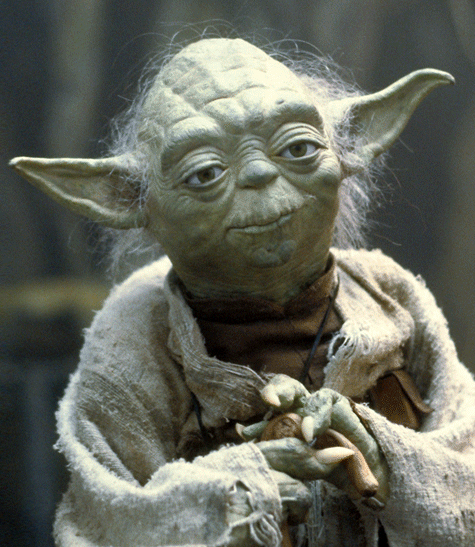
by Julienne Givot | Jan 12, 2012 | Major Arcana Heros Journey, Podcasts, Pop Culture Archetypes |
Listen Now! or Subscribe in iTunes
 The Sixth edition of the Archetypal Tarot Podcast explores the meaning of the Hierophant card of the Tarot as a stage of a journey where one examines the traditions, organizations and structures of one’s life as well as how and who to seek higher guidance from. The Hierophant, also called the Pope card in traditional Tarot decks also symbolizes the archetypes of the Priest, Guide, Guru, Shaman,Wise Man and Messiah. Truly a symbol of higher wisdom, this card is a symbol of seeking greater or spiritual knowledge.
The Sixth edition of the Archetypal Tarot Podcast explores the meaning of the Hierophant card of the Tarot as a stage of a journey where one examines the traditions, organizations and structures of one’s life as well as how and who to seek higher guidance from. The Hierophant, also called the Pope card in traditional Tarot decks also symbolizes the archetypes of the Priest, Guide, Guru, Shaman,Wise Man and Messiah. Truly a symbol of higher wisdom, this card is a symbol of seeking greater or spiritual knowledge.
Listen in on a conversation with
Tarot Dream Stone consultant Cyndera Quakenbush and
Archetypal Consultant, Julienne Givot, as they discuss the symbolic and real world qualities of these archetypal characters.
Archetypes of the Hierophant:
God
Wise Man
Priest
Shaman
Guru
Guide
Messiah
Examples of the Heirophant Archetype’s light aspects in Film:
- Yoda in the Star Wars series
- Laurence Fishburne “The Matrix” trilogy (Priest/Wiseman)
- Ben Kingsley in “Gandhi” (1982)
- Pat Morita in “The Karate Kid” (1984)
Examples of the Heirophant Archetype’s shadow aspects in Film:
- Paul Dano in “There Will Be Blood” (2007)
- Tom Cruise in “Magnolia” (1999)
- Robert Mitchum in “The Night of the Hunter” (1955)
Like what you heard on the podcast? Share us on Facebook (handy button below) or give us a review on iTunes.
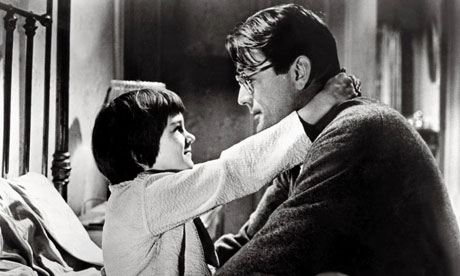
by Julienne Givot | Dec 12, 2011 | Archetypal Characters, Major Arcana Heros Journey, Podcasts, Pop Culture Archetypes |
 The Fifth edition of the Archetypal Tarot Podcast explores the meaning behind the Emperor card of the Tarot as a stage of a journey where one is asked to create structure and practical plans for your project or dream so that it can be fortified before going on to the next stage of the journey. The Emperor symbolizes the archetype of the Father as well as the King. Listen in as Julienne and Cyndera discuss these important patterns to our growth and flourishing.
The Fifth edition of the Archetypal Tarot Podcast explores the meaning behind the Emperor card of the Tarot as a stage of a journey where one is asked to create structure and practical plans for your project or dream so that it can be fortified before going on to the next stage of the journey. The Emperor symbolizes the archetype of the Father as well as the King. Listen in as Julienne and Cyndera discuss these important patterns to our growth and flourishing.
Listen Now! or Subscribe in iTunes
Listen in on a conversation with
Tarot Dream Stone consultant Cyndera Quakenbush and
Archetypal Consultant, Julienne Givot, as they discuss the symbolic and real world qualities of these archetypal characters.
Books mentioned in the podcast:
We: Understanding the Psychology of Romantic Love by Robert A. Johnson
He: Understanding Masculine Psychology by Robert A. Johnson
She: Understanding Feminine Psychology by Robert A. Johnson
Below is an expanded list of these two archetypes in popular culture.
Examples of the Father Archetype’s light aspects in Film and Television:
 Gregory Peck in ”To Kill a Mockingbird'”(1962)
Gregory Peck in ”To Kill a Mockingbird'”(1962)- Frances McDormand in “Almost Famous” (2000)
- Bill Cosby in “The Cosby Show”
- Will Smith in “The Pursuit of Happyness” (2006)
- Paddy Constantine in “In America” – (2002) directed by Jim Sheridan
- Sean Connery in “Indiana Jones and the Last Crusade” (1989) both shadow and light
- “Riding Alone for Thousands of Miles” (2005) directed by Zhang Yimou
- Alan Arkin in “Edward Scissorhands” (1990)
- Felicity Huffman in “Transamerica” (2005)
Examples of the Father Archetype’s shadow aspects in Film and Television:
- Jon Hamm in “Mad Men” (AMC)
- John Lithgow in “Dexter” (Showtime) and “Footloose” (1984)
- Kevin Spacey in “American Beauty” (1999)
- James Gandolfini in “The Sopranos” (HBO)
Examples of some of the shadow and light characteristics of the Father archetype but also an example of the cultures misunderstanding of this archetype:
- John Cryer in “Two and Half Men” (CBS)
- Homer Simpson in “The Simpsons” (FOX)
- Ed O’Neill in “Married with Children” (ABC)
Examples of the King Archetype’s light aspects in Film and Television:
- Edward James Olmos in Battlestar Gallactica (SciFi Channel) (both aspects)
- Colin Firth in “The King’s Speech” (2010)
- William Moseley as Peter in the Narnia Chronicle series
- Keisha Castle Hughes and Rawiri Paratene in Whalerider (2002)
- Sean Connery in “The Man Who Would be King, First Knight, Time Bandits (both aspects)
- Good King Wenceslas (myth / song)
Examples of the Father Archetype’s shadow aspects in Film and Television:
- Marlon Brando in The Godfather (king/father)
- Christopher Walken in “The King of New York” (1990)
- James Gandolfini in “The Sopranos (HBO)
- Darth Vader in Star Wars
- John Noble as Lord Denethor in the “Lord of The Rings: Return of the King” (2003)
Like what you heard on the podcast? Share us on Facebook (handy button below) or give us a review on iTunes.

by Julienne Givot | Sep 19, 2011 | All Articles, Podcasts |
 I’ve partnered with my friend and colleague Cyndera Quakenbush to publish a new series of podcasts on archetypes. We are exploring the archetypes of the first 22 cards Tarot (also called the Major Arcana) as both individual patterns and as stages of a journey.
I’ve partnered with my friend and colleague Cyndera Quakenbush to publish a new series of podcasts on archetypes. We are exploring the archetypes of the first 22 cards Tarot (also called the Major Arcana) as both individual patterns and as stages of a journey.
Search for ‘Archetypal Tarot’ in your iTunes Store or visit our Podcast site http://archetypaltarot.podbean.com/ to subscribe using the links on the lower right. Each podcast is between 25 and 35 minutes long and is packed with insights, examples of the archetypes in modern life.
Feel free to leave comments, rate the podcast or submit a question.
If you’ve ever thought of the Tarot as just a card game used for fortune telling, you’ll be surprised at the insights found in these ancient images. We go beyond superstition and look a the Tarot as universal stories, stages and characters we see in our lives every day.
What is a podcast?
pod·cast/ˈpädˌkast/
Verb: Make (a multimedia digital file) available as a podcast.
Noun: A multimedia digital file made available on the Internet for downloading to a portable media player, computer, etc.









 Angel & Fairy Godmother/Godfather Archetypes in Films & Television:
Angel & Fairy Godmother/Godfather Archetypes in Films & Television:

 Who knew that Death could be so funny? But here it is, card number 13 in the Major Arcana. Join Julienne and Cyndera as they look at the archetype of Death from a symbolic and psychological point of view with a dash of added humor. Learn why this inevitable stage for the Hero isn’t the end but an important element to the rest of the journey.
Who knew that Death could be so funny? But here it is, card number 13 in the Major Arcana. Join Julienne and Cyndera as they look at the archetype of Death from a symbolic and psychological point of view with a dash of added humor. Learn why this inevitable stage for the Hero isn’t the end but an important element to the rest of the journey.







 Examples of the Gambler/Wheel of Fortune Archetype in film:
Examples of the Gambler/Wheel of Fortune Archetype in film: 
 that only remote regions can give. Card number 9 allows our hero traveling through the Major Arcana to either meet or become this humbled figure full of in-sight, as represented by his seeking lantern. A re-evaluation of his journey is required after a run-in with the objectivity of Justice, before he can once again chance the Wheel of Fortune (Card number 10). Consideration of this card allows us all a moment to reflect without being sucked into eternal isolation – the shadow side of the Hermit. Fresh from a (hot) visit from her hometown of Joshua Tree, California, Cyndera shares fresh inspiration after encountering an old friend who embodies the Hermit archetype. Julienne takes us on a tour of the hermitic nature of the American literary Renaissance along with some insights on the Hermit from film and popular culture.
that only remote regions can give. Card number 9 allows our hero traveling through the Major Arcana to either meet or become this humbled figure full of in-sight, as represented by his seeking lantern. A re-evaluation of his journey is required after a run-in with the objectivity of Justice, before he can once again chance the Wheel of Fortune (Card number 10). Consideration of this card allows us all a moment to reflect without being sucked into eternal isolation – the shadow side of the Hermit. Fresh from a (hot) visit from her hometown of Joshua Tree, California, Cyndera shares fresh inspiration after encountering an old friend who embodies the Hermit archetype. Julienne takes us on a tour of the hermitic nature of the American literary Renaissance along with some insights on the Hermit from film and popular culture. I also found it amusingly appropriate that Led Zeppelin used the image of the Hermit for their single ‘Stairway To Heaven’ which carries lyrics capturing the ideas of the Hermit’s quest.
I also found it amusingly appropriate that Led Zeppelin used the image of the Hermit for their single ‘Stairway To Heaven’ which carries lyrics capturing the ideas of the Hermit’s quest. is number 8 of the Major Arcana.
is number 8 of the Major Arcana.
 The Eighth edition of the Archetypal Tarot Podcast explores the movement and meaning encompassed by the Chariot, card number 7 of the
The Eighth edition of the Archetypal Tarot Podcast explores the movement and meaning encompassed by the Chariot, card number 7 of the 
 The Seventh edition of the Archetypal Tarot podcast reveals our heroic Fool at his/her first genuine choice point represented by card number six, The Lovers. The Lovers brings into focus this important first choice and reminds us that love, balance and companionship are called for. This stage has us examine the archetypes of the Lover as well as the Companion. A reminder to access both our masculine ‘doing-ness’ and feminine receptivity.
The Seventh edition of the Archetypal Tarot podcast reveals our heroic Fool at his/her first genuine choice point represented by card number six, The Lovers. The Lovers brings into focus this important first choice and reminds us that love, balance and companionship are called for. This stage has us examine the archetypes of the Lover as well as the Companion. A reminder to access both our masculine ‘doing-ness’ and feminine receptivity.

 The Sixth edition of the Archetypal Tarot Podcast explores the meaning of the Hierophant card of the Tarot as a stage of a journey where one examines the traditions, organizations and structures of one’s life as well as how and who to seek higher guidance from. The Hierophant, also called the Pope card in traditional Tarot decks also symbolizes the archetypes of the Priest, Guide, Guru, Shaman,Wise Man and Messiah. Truly a symbol of higher wisdom, this card is a symbol of seeking greater or spiritual knowledge.
The Sixth edition of the Archetypal Tarot Podcast explores the meaning of the Hierophant card of the Tarot as a stage of a journey where one examines the traditions, organizations and structures of one’s life as well as how and who to seek higher guidance from. The Hierophant, also called the Pope card in traditional Tarot decks also symbolizes the archetypes of the Priest, Guide, Guru, Shaman,Wise Man and Messiah. Truly a symbol of higher wisdom, this card is a symbol of seeking greater or spiritual knowledge.
 The Fifth edition of the Archetypal Tarot Podcast explores the meaning behind the Emperor card of the Tarot as a stage of a journey where one is asked to create structure and practical plans for your project or dream so that it can be fortified before going on to the next stage of the journey. The Emperor symbolizes the archetype of the Father as well as the King. Listen in as Julienne and Cyndera discuss these important patterns to our growth and flourishing.
The Fifth edition of the Archetypal Tarot Podcast explores the meaning behind the Emperor card of the Tarot as a stage of a journey where one is asked to create structure and practical plans for your project or dream so that it can be fortified before going on to the next stage of the journey. The Emperor symbolizes the archetype of the Father as well as the King. Listen in as Julienne and Cyndera discuss these important patterns to our growth and flourishing. Gregory Peck in ”To Kill a Mockingbird'”(1962)
Gregory Peck in ”To Kill a Mockingbird'”(1962)